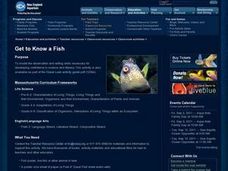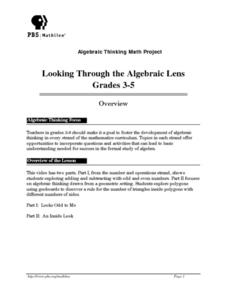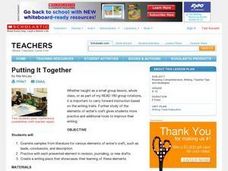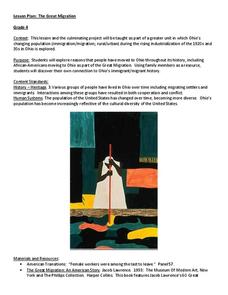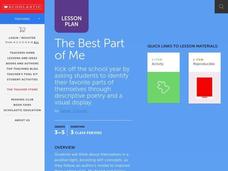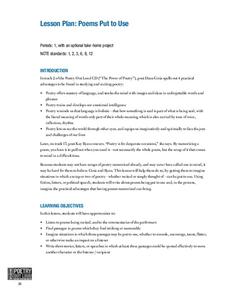Curated OER
Island of the Blue Dolphins Jigsaw
Fourth graders research three topics from the book, either Village Life, Sea Life, or San Nicholas Island. They research independently and meet in a jigsaw format to share what they learned. As group they create a poster for class...
Curated OER
Monster Fun Learning the Five Senses
Students explore the five senses. In this health lesson, students read the book Brave Little Monster and identify the five senses from the book. Students draw an illustration from the book as a follow-up activity.
Curated OER
Beisbol! Latino Baseball Pioneers and Legends
Students explore Latin America by researching the favorite past time, baseball. In this Latin culture lesson, students identify the leaders in the Latin American baseball movement such as Felipe Alou, Jose Mendze, and the great Roberto...
Curated OER
Get to Know a Fish
Students discover the anatomy of a fish by identifying its body parts. In this oceanography lesson plan, students view a live fish in their classroom and draw a poster of the fish one body part at a time while identifying it....
Curated OER
A Conventional Family
Students explore writing techniques by analyzing their own families. In this family values lesson, students view the film "The Incredibles" in class and discuss the different types of modern-day families. Students write about their...
Curated OER
Taking Care of a Baby
Caring for a newborn is harder than it looks! Elementary pupils learn more about taking care of babies with an age-appropriate lesson that addresses how babies grow inside their mothers, what they need to grow, and how members...
Curated OER
Pronouns and Nouns
Second graders identify nouns and pronouns from a story. In this nouns and pronouns lesson, 2nd graders review the definition of these words. Students then locate nouns and pronouns in the book they are reading. Students list these words...
Curated OER
Learning About Animals' Bodies
Students research different animals (mammals, reptiles, amphibians, insects, birds, fish) and create books, murals, dioramas, puppets, and sculptures to illustrate the necessity of various body parts for overall survival. In this animal...
Curated OER
Where Do I Belong? - Part Two
Students organize library books using their library catalogue numbers. In this library books lesson, students receive four books to identify and then place in order according to their library information.
Curated OER
One Size Fits All, Part 1
Can you tell how tall someone is just by looking at their feet? In this activity, young mathematicians measure their height, arm span, and foot size, graph their findings, and answer questions about how these measurements are related....
EngageNY
Developing Reading Fluency: Criteria for Reading Aloud
Third graders develop their reading superpowers in a lesson plan on fluency. After first listening to an audio recording or teacher read aloud, the class works together identifying criteria for fluent reading, focusing on phrasing, rate,...
Curated OER
The Tale of Peter Rabbit
Wow! Here is a most-impressive series of lessons and activities that revolve around the classic story, The Tale of Peter Rabbit. The purpose of the lessons are to provide an agricultural theme in the reading, writing, and science...
Baylor College
Neurotransmitters Contain Chemicals
Human body systems young scholars play a card game, "Locks & Keys" in order to learn that neurotransmitters carry a message from one neuron to another by fitting into a receptor site on the receiving nerve cell. While this activity...
Curated OER
Traveling Through the Digestive System
Second graders learn about how the food is broken down in our bodies and the job of each body part involved in our digestive system. The utilize the CD ROM game, "Body Works." This wonderful game takes pupils through the human body's...
Curated OER
Looking Through the Algebraic Lens
Students work with rectangles to find generalizations for adding and subtracting odd and even numbers in part one of the lesson. In part two, students use geoboards to construct polygons, look for patterns, and find a general rule.
Baylor College
What Is a Neuron?
Your class won't get on your nerves while doing this modeling activity! After teaching the structure and function of a neuron using the included diagrams, give individuals some clay and chenille stems so that they can make their own...
Baylor College
Drugs, Risks and the Nervous System
In cooperative groups, middle schoolers contemplate the probability of 18 different situations occurring. After they make predictions, they compare them to the actual risk factors. This eye-opening exercise demonstrates that the odds of...
Curated OER
Putting It Together in Writer's Workshop
This lesson about writing can be taught in small groups or large group settings. They examine basic writing techniques and practice using them to improve their writing.
Curated OER
The Great Migration
What a terrific instructional activity! Have your class learn about immigration using this resource. Fourth graders discuss the Great Migration in Ohio through art, writing, and discussion. Afterward, they create a presentation in which...
Baylor College
Measuring and Protecting Skin
Several subjects are addressed within the context of a science instructional activity about the sun's ultraviolet rays. Elementary earth scientists consider protection of the skin with sunscreens (health), estimating and measuring...
Curated OER
Best Part of Me
Students determine a positive physical feature of themselves. They participate in an online writer's workshop and write descriptive poem about their favorite feature. They create a display of poetry and pictures.
Baylor College
Heart and Lungs
With a partner, youngsters measure their pulse and breathing rates, both at rest and after running in place for a minute. While this activity is not novel, the lesson plan includes a large-scale classroom graphing activity and other...
Curated OER
East Timor: The World's Newest Country
This isn't just a hand-out or a reading passage; it's more like a mini book on the history, colonization, independence, and culture of the South East Asian country of Timor. There are extensive readings and discussion questions for...
Poetry Out Loud
Poems Put to Use
Why do we have to study poetry? Here is a lesson that demonstrates some of poetry's more practical and real-world applications for reluctant learners. Start by leading a brainstorming session about where poems or pieces of poems might be...



